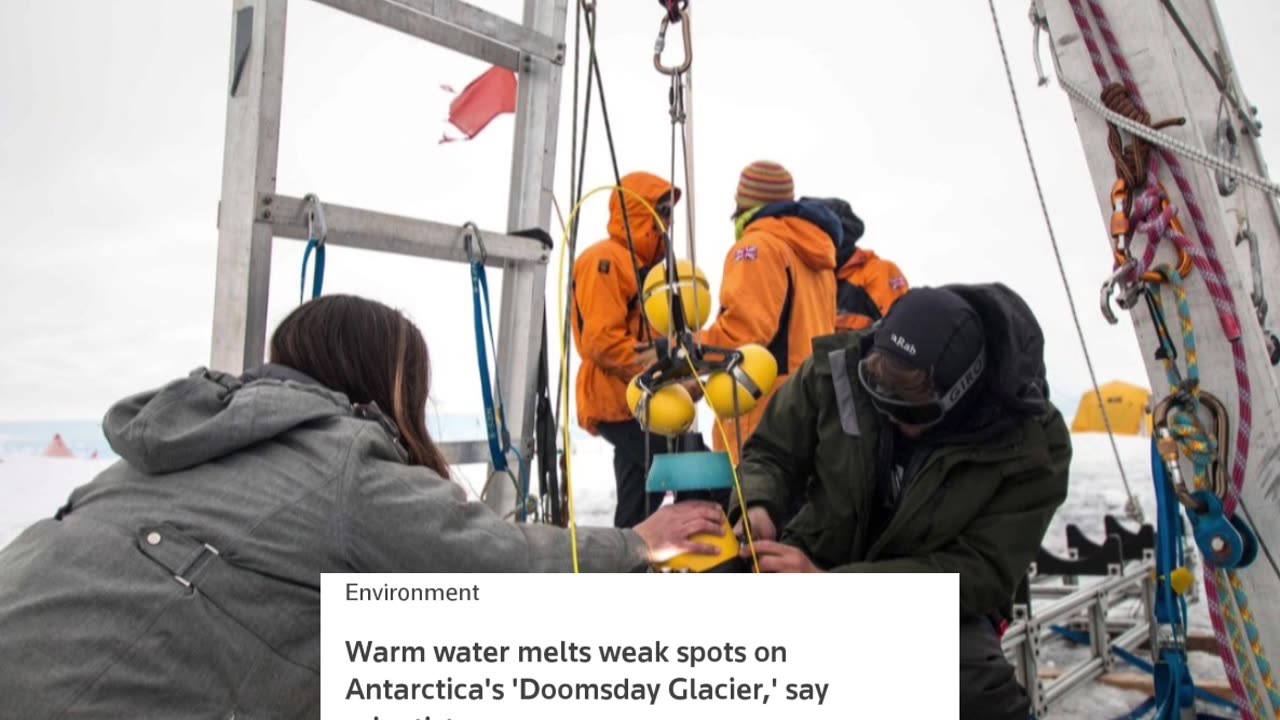Premium Only Content

Warm water melts weak spots on Antarctica's 'Doomsday Glacier,' say scientists
Warm water melts weak spots on
Antarctica's 'Doomsday Glacier,' say
scientists
Scientists studying Antarctica's vast Thwaites Glacier - nicknamed the Doomsday Glacier - say warm water is seeping into its weak spots, worsening melting caused by rising temperatures, two papers published in Nature journal showed on Wednesday.
Thwaites, which is roughly the size of Florida, represents more than half a meter (1.6 feet) of global sea level rise potential, and could destabilize neighboring glaciers that have the potential to cause a further three-meter (9.8-foot) rise.As part of the International Thwaites Glacier collaboration - the biggest field campaign ever attempted in Antarctica - a team of 13 U.S. and British scientists spent about six weeks on the glacier in late 2019 and early 2020.
Using an underwater robot vehicle known as Icefin, mooring data and sensors, they monitored the glacier's grounding line, where ice slides off the glacier and meets the ocean for the first time.In one of the papers, led by Cornell University-based scientist Britney Schmidt, researchers found that warmer water was making its way into crevasses and other openings known as terraces, causing sideways melt of 30 meters (98 feet) or more per year.
"Warm water is getting into the weakest parts of the glacier and making it worse," Schmidt told Reuters.
"That is the kind of thing we should all be very concerned about," she said about the findings which underscored how climate change is reaching isolated Antarctica.
The other paper's findings, which Schmidt also worked on, showed about five meters (16 feet) per year of melt near the glacier's grounding line - less than what the most aggressive thinning models previously predicted.
But she said the melting was still of grave concern.
"If we observe less melting... that doesn't change the fact that it's retreating," Schmidt said.
Scientists have previously depended on satellite images to show the behavior of the ice, making it difficult to get granular details. The papers represent the first time a team has been to the grounding line of a major glacier, providing a look right where "the action begins," Schmidt said.
The findings will help in the development of climate change models, said Paul Cutler, program director of Antarctic Sciences at the National Science Foundation. He reviewed the papers, but was not involved in the research.
"These things can now be taken on board in the models that will predict the future behavior, and that was exactly the goal of this work," he said.
(This story has been refiled to change 'censors' to 'sensors' in paragraph 4)
-
 DVR
DVR
Man in America
6 hours agoThe Elites Are Losing Their War on Our Children w/ Robert Bortins
6.05K -
 LIVE
LIVE
I_Came_With_Fire_Podcast
9 hours agoGovt' Shutdowns, VA Scandals, MORE Drones, Syrian Strikes and staged rescues , and The DHS!
1,067 watching -
 56:55
56:55
The StoneZONE with Roger Stone
4 hours agoTrump Should Sue Billionaire Governor JB Pritzker for Calling Him a Rapist | The StoneZONE
21.5K5 -
 59:21
59:21
Adam Does Movies
4 hours ago $0.66 earnedMore Reboots + A Good Netflix Movie + Disney Live-Action Rant - LIVE
23.1K -
 36:28
36:28
TheTapeLibrary
13 hours ago $0.44 earnedThe Disturbing True Horror of the Hexham Heads
45.1K5 -
 LIVE
LIVE
JdaDelete
23 hours ago $0.15 earnedHalo MCC with the Rumble Spartans 💥
505 watching -
 3:52:22
3:52:22
Edge of Wonder
7 hours agoChristmas Mandela Effects, UFO Drone Updates & Holiday Government Shake-Ups
24.2K2 -
 1:37:36
1:37:36
Mally_Mouse
6 hours agoLet's Play!! -- Friends Friday!
33.1K -
 57:45
57:45
LFA TV
1 day agoObama’s Fake World Comes Crashing Down | Trumpet Daily 12.20.24 7PM EST
28.5K11 -
 1:27:17
1:27:17
2 MIKES LIVE
5 hours ago2 MIKES LIVE #158 Government Shutdown Looms and Games!
26.4K9